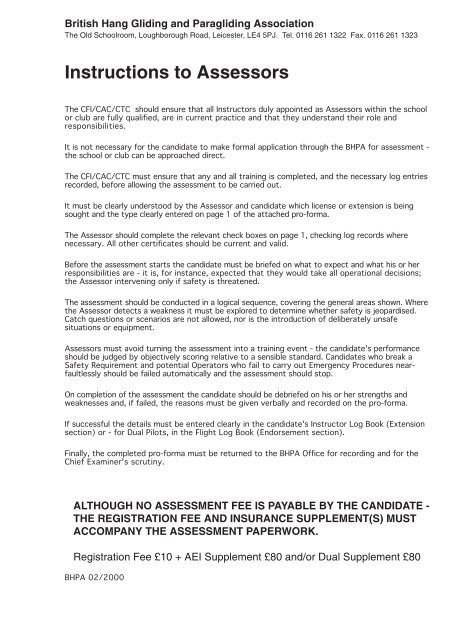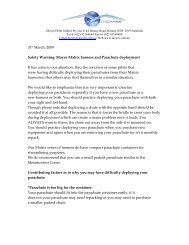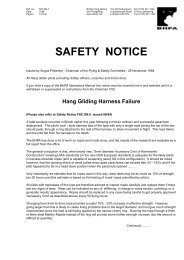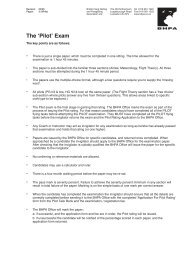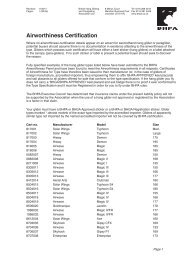Instructions to Assessors - British Hang Gliding and Paragliding ...
Instructions to Assessors - British Hang Gliding and Paragliding ...
Instructions to Assessors - British Hang Gliding and Paragliding ...
You also want an ePaper? Increase the reach of your titles
YUMPU automatically turns print PDFs into web optimized ePapers that Google loves.
<strong>British</strong> <strong>Hang</strong> <strong>Gliding</strong> <strong>and</strong> <strong>Paragliding</strong> AssociationThe Old Schoolroom, Loughborough Road, Leicester, LE4 5PJ. Tel. 0116 261 1322 Fax. 0116 261 1323<strong>Instructions</strong> <strong>to</strong> <strong>Assessors</strong>The CFI/CAC/CTC should ensure that all Instruc<strong>to</strong>rs duly appointed as <strong>Assessors</strong> within the schoolor club are fully qualified, are in current practice <strong>and</strong> that they underst<strong>and</strong> their role <strong>and</strong>responsibilities.It is not necessary for the c<strong>and</strong>idate <strong>to</strong> make formal application through the BHPA for assessment -the school or club can be approached direct.The CFI/CAC/CTC must ensure that any <strong>and</strong> all training is completed, <strong>and</strong> the necessary log entriesrecorded, before allowing the assessment <strong>to</strong> be carried out.It must be clearly unders<strong>to</strong>od by the Assessor <strong>and</strong> c<strong>and</strong>idate which license or extension is beingsought <strong>and</strong> the type clearly entered on page 1 of the attached pro-forma.The Assessor should complete the relevant check boxes on page 1, checking log records wherenecessary. All other certificates should be current <strong>and</strong> valid.Before the assessment starts the c<strong>and</strong>idate must be briefed on what <strong>to</strong> expect <strong>and</strong> what his or herresponsibilities are - it is, for instance, expected that they would take all operational decisions;the Assessor intervening only if safety is threatened.The assessment should be conducted in a logical sequence, covering the general areas shown. Wherethe Assessor detects a weakness it must be explored <strong>to</strong> determine whether safety is jeopardised.Catch questions or scenarios are not allowed, nor is the introduction of deliberately unsafesituations or equipment.<strong>Assessors</strong> must avoid turning the assessment in<strong>to</strong> a training event - the c<strong>and</strong>idate's performanceshould be judged by objectively scoring relative <strong>to</strong> a sensible st<strong>and</strong>ard. C<strong>and</strong>idates who break aSafety Requirement <strong>and</strong> potential Opera<strong>to</strong>rs who fail <strong>to</strong> carry out Emergency Procedures nearfaultlesslyshould be failed au<strong>to</strong>matically <strong>and</strong> the assessment should s<strong>to</strong>p.On completion of the assessment the c<strong>and</strong>idate should be debriefed on his or her strengths <strong>and</strong>weaknesses <strong>and</strong>, if failed, the reasons must be given verbally <strong>and</strong> recorded on the pro-forma.If successful the details must be entered clearly in the c<strong>and</strong>idate's Instruc<strong>to</strong>r Log Book (Extensionsection) or - for Dual Pilots, in the Flight Log Book (Endorsement section).Finally, the completed pro-forma must be returned <strong>to</strong> the BHPA Office for recording <strong>and</strong> for theChief Examiner's scrutiny.ALTHOUGH NO ASSESSMENT FEE IS PAYABLE BY THE CANDIDATE -THE REGISTRATION FEE AND INSURANCE SUPPLEMENT(S) MUSTACCOMPANY THE ASSESSMENT PAPERWORK.Registration Fee £10 + AEI Supplement £80 <strong>and</strong>/or Dual Supplement £80BHPA 02/2000
Revision: 03/08Pages: 2 (White)Page 1 of 2.<strong>British</strong> <strong>Hang</strong> <strong>Gliding</strong><strong>and</strong> <strong>Paragliding</strong>Association LtdThe Old SchoolroomLoughborough RoadLeicester LE4 5PJTel (0116) 261 1322www.bhpa.co.ukFax (0116) 261 1323ASSESSMENT - OPERATORPRACTICAL ELEMENTGENERAL TOW UNIT CONTROL Poor Fair Avg Good V GoodAbility <strong>to</strong> assess conditions ■ ■ ■ ■ ■Briefing of <strong>to</strong>w unit crew (as appropriate) ■ ■ ■ ■ ■Positioning of <strong>to</strong>w unit for launch ■ ■ ■ ■ ■Take-off control & underst<strong>and</strong>ing ■ ■ ■ ■ ■During <strong>to</strong>w, control & underst<strong>and</strong>ing ■ ■ ■ ■ ■Reaction <strong>to</strong> tensiometer readings ■ ■ ■ ■ ■Reaction <strong>to</strong> signals ■ ■ ■ ■ ■Ability <strong>to</strong> assess height ■ ■ ■ ■ ■L<strong>and</strong>ing Control & techniques (PA Round only) ■ ■ ■ ■ ■Tow line management ■ ■ ■ ■ ■Ability <strong>to</strong> cope with varying conditions ■ ■ ■ ■ ■Tow unit (<strong>and</strong> ancillary units) management ■ ■ ■ ■ ■Underst<strong>and</strong>ing of suitability of <strong>to</strong>w unit type ■ ■ ■ ■ ■EMERGENCY PROCEDURES Poor Fair Avg Good V Good*Reaction <strong>to</strong> glider getting off line:a) glider slowly turning off linei) ground/low level ■ ■ ■ ■ ■ii) high level ■ ■ ■ ■ ■b) glider rapidly turning off linei) ground/low level ■ ■ ■ ■ ■ii) high level ■ ■ ■ ■ ■* At least one of these items MUST be completed practically but only as a ‘role play’ imagined event (ie,during a perfectly normal <strong>to</strong>w the assessor declares that this, that or the other is happening <strong>to</strong> the glider <strong>and</strong>the opera<strong>to</strong>r should respond accordingly). The other scenarios may be assessed through discussion.The minimum acceptable st<strong>and</strong>ard is ‘Average’EQUIPMENT CARE & MAINTAINANCE Poor Fair Avg Good V GoodAbility <strong>to</strong> repair <strong>to</strong>w lines ■ ■ ■ ■ ■Awareness of need <strong>to</strong> have tensiometer checked regularly ■ ■ ■ ■INTERVIEW ELEMENTPRE-OPERATIONAL REQUIREMENTS Poor Fair Avg Good V GoodUnderst<strong>and</strong>ing of who is in charge <strong>and</strong> why ■ ■ ■ ■ ■DRIVING & EMERGENCIES Poor Fair Avg Good V GoodImportance of all round vision ■ ■ ■ ■ ■Causes of rotation/lockout ■ ■ ■ ■ ■Dangers of ‘rocket’ take off ■ ■ ■ ■ ■Dangers of <strong>to</strong>o slow a take off ■ ■ ■ ■ ■Dangers of near stall take off ■ ■ ■ ■ ■Importance of canopy/glider position relative <strong>to</strong> <strong>to</strong>w line ■ ■ ■ ■ ■Awareness of need <strong>to</strong> release both line ends in emergency ■ ■ ■ ■ ■
Assessment - Opera<strong>to</strong>r Page 2 of 2CARE & MAINTENANCE OF EQUIPMENT Poor Fair Avg Good V GoodUnderst<strong>and</strong>ing of breaking loads of line ■ ■ ■ ■ ■Underst<strong>and</strong>ing of weakening effects of knots ■ ■ ■ ■ ■Preferred methods of line s<strong>to</strong>rage <strong>and</strong> reasons ■ ■ ■ ■ ■Knowledge of tensiometer hysteresis ■ ■ ■ ■ ■Knowledge of tensiometer calibration/reliability ■ ■ ■ ■ ■Knowledge of serviceability/maintenance of <strong>to</strong>w unit ■ ■ ■ ■ ■KNOWLEDGE AND UNDERSTANDINGOF SAFETY REQUIREMENTS Poor Fair Avg Good V GoodGeneral ■ ■ ■ ■ ■Tow launch ■ ■ ■ ■ ■Specific bans ■ ■ ■ ■ ■Purpose of weak link ■ ■ ■ ■ ■Permitted weak link values ■ ■ ■ ■ ■FLIGHT SAFETY Poor Fair Avg Good V GoodBasic airfield procedure <strong>and</strong> signals ■ ■ ■ ■ ■Awareness of other sports in close proximity ■ ■ ■ ■ ■
THE CHIEF EXAMINER’S BRIEFThe assessor should read out each point in the relevant section below in turn <strong>and</strong> satisfy himselfthat the newly qualified member is aware of the added responsibilities. He should ensure thathe has recorded the details of the qualification in the c<strong>and</strong>idate’s Instruc<strong>to</strong>r LogBook - the entry must be clear <strong>and</strong> signed <strong>and</strong> dated by the Assessor.To All Successful C<strong>and</strong>idates:The chairman of the Flying <strong>and</strong> Safety Committee wants you <strong>to</strong> be made aware of the followingpoints:1. You may only operate, instruct or supervise in the disciplines shown on your licence <strong>and</strong> in theLicence Extensions section of your Instruc<strong>to</strong>r Log Book.2. When acting as a qualified BHPA member you have a DUTY OF CARE <strong>to</strong>wards those whom you are<strong>to</strong>wing, carrying or instructing. Don’t be intimidated by anyone <strong>to</strong> carry out operations or trainingthat you are not happy with; <strong>and</strong> do not hesitate <strong>to</strong> cease flying or restrict or repeat exercises.3. Treat every situation as unique - students, <strong>to</strong>ws <strong>and</strong> flights. Be ready for the unexpected <strong>and</strong>remember that the weather can change dramatically, especially in hilly terrain, near the coast, orin the summer.4. You must comply with the requirements laid down in the BHPA Technical Manual; <strong>and</strong> you shouldread, take note <strong>and</strong> act on all Safety <strong>and</strong> Training information which may appear in the SKYWINGSmagazine, plus any official Safety Notices you may receive.5. SAFETY REQUIREMENTS, RECOMMENDED PRACTICES AND OPERATINGPROCEDURES MUST BE FOLLOWED.To Licenced Instuc<strong>to</strong>rs gaining an additional Extension:1. You MUST warn all newcomers <strong>to</strong> the sport about the RISK of injury. It is a sport - NOT a funfair ride.2. Make certain that every student is a BHPA member - issue an introduc<strong>to</strong>ry Membershipcertificate or check their BHPA membership card.3. If you’re not sure whether <strong>to</strong> submit an Incident Report, then send it in anyway.4.The issue of your licence means you are considered competent <strong>to</strong> operate unsupervised <strong>and</strong> <strong>to</strong>train students <strong>and</strong> pilots <strong>to</strong> all levels within the permitted categories but you still have much <strong>to</strong>learn.To newly Licenced Opera<strong>to</strong>rs:1. You may now operate the <strong>to</strong>w unit providing that there is a suitably qualified Instruc<strong>to</strong>r or TowCoach in charge of the operation.To newly Licenced Dual Pilots:1. You MUST warn all newcomers <strong>to</strong> the sport about the RISK of injury. It is a sport - NOT a funfair ride.2. If you’re not sure whether or not <strong>to</strong> submit an Incident Report, then send it in anyway.3. When operating within a school you must ensure that anyone you carry is a BHPA member.Outside a school environment this procedure is strongly recommended.NOTE:THIS QUALIFICATION (AND THE ATTACHED BENEFITS) IS VALID ONLY WHENUSED WITHIN A REGISTERED BHPA SCHOOL OR CLUB.BHPA 12/06


